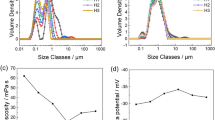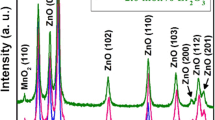Abstract
The effects of polyvinyl alcohol (PVA) on the slurry, granules, green bodies, and sintered varistors were investigated. The results showed that PVA inclusion as a binder not only influenced the mechanical properties of the granules, but also significantly impacted on the dispersibility of the slurry, the microstructure's uniformity, the compactness, and the element doping homogeneity of the varistors. These effects greatly affected the electrical properties, including the non-linear characteristics and the energy withstand capability. The optimal PVA concentration was found to be 0.7 wt%, resulting in varistors with excellent electrical properties: breakdown voltage gradient of 247.7 V/mm, nonlinearity coefficient of 41.0, residual voltage ratio of 1.71 under an 8/20 μs impulse current of 5 kA, and 100% pass rate under 2 ms rectangular waveform impulses of 900 A.










Similar content being viewed by others
Data availability
The authors declare that the data supporting the findings of this study are available within the paper and its Supplementary Information files. Should any raw data files be needed in another format they are available from the corresponding author upon reasonable request.
References
M. Houabes, R. Metz, Rare earth oxides effects on both the threshold voltage and energy absorption capability of ZnO varistors. Ceram. Int. 33(7), 1191–1197 (2007)
D.R. Clarke, Varistor ceramics. J. Am. Ceram. Soc. 82(3), 485–502 (1999)
F. Abedsaeidi, A. Amini, F. Norouzian, M.K. Javan, M.M. Shahraki, The effect of grinding media on suspensions, microstructures, and comprehensive electrical properties of ZnO varistors. J. Mater. Sci. 33(27), 21727–21736 (2022)
Z. Cheng, R. Li, Y. Long, J. Li, S. Li, K. Wu, Power loss transition of stable ZnO varistor ceramics: Role of oxygen adsorption on the stability of interface states at the grain boundary. J. Adv. Ceram. 12(5), 972–983 (2023)
T. Tian, L.Y. Zheng, M. Podlogar, Z.Y. Man, X.Z. Ruan, X. Shi, S. Bernik, G.R. Li, Influence of Ca-doping on the nonlinear properties of novel ZnO-Cr2O3-based varistor ceramics. J. Eur. Ceram. Soc. 42(5), 2268–2273 (2022)
C.H. Lu, N. Chyi, H.W. Wong, W.J. Hwang, Effects of additives and secondary phases on the sintering behavior of zinc oxide-based varistors. Mater. Chem. Phys. 62(2), 164–168 (2000)
C. Tsonos, A. Kanapitsas, D. Triantis, C. Anastasiadis, I. Stavrakas, P. Pissis, E. Neagu, Interface states and MWS polarization contributions to the dielectric response of low voltage ZnO varistor. Ceram. Int. 37(1), 207–214 (2011)
M. Guo, X. Zhao, W.D. Shi, B.Y. Zhang, K.N. Wu, J.Y. Li, Simultaneously improving the electrical properties and long-term stability of ZnO varistor ceramics by reversely manipulating intrinsic point defects. J. Eur. Ceram. Soc. 42(1), 162–168 (2022)
K. Hembram, T.N. Rao, R.S. Srinivasa, A.R. Kulkarni, CaO doped ZnO–Bi2O3 varistors: grain growth mechanism, structure and electrical properties. Ceram. Int. 47(1), 1229–1237 (2021)
S. Roy, D. Das, T.K. Roy, Nonlinear electrical properties of ZnO-V2O5 based rare earth (Er2O3) added varistors. J. Electron. Mater. 48(9), 5650–5661 (2019)
A. Sedky, T.A. El-Brolossy, S.B. Mohamed, Correlation between sintering temperature and properties of ZnO ceramic varistors. J. Phys. Chem. Solids 73(3), 505–510 (2012)
J. Warycha, W. Mielcarek, G. Lesiuk, On the relationship between modification of Bi2O3 by Sb and type of grain boundaries in ZnO-based varistors. Eng. Fail. Anal. 122, 105251 (2021)
S.L. Jiang, Y.P. Wang, X.S. Zhang, Y.C. Xu, P. Liu, Y.K. Zeng, Q. Wang, G.Z. Zhang, Effect of Zn doping on stability of ZnO varistors under high pulse-current stress. Ceram. Int. 41(9), 11611–11617 (2015)
J. Rao, A. Yu, C.L. Shao, X.F. Zhou, Construction of hollow and mesoporous ZnO microsphere: a facile synthesis and sensing property. ACS Appl. Mater. Interfaces 4(10), 5346–5352 (2012)
L. Zhang, J.H. Gao, W.F. Liu, Q.R. Guo, S.T. Li, J.Y. Li, Simultaneously enhanced electrical stability and nonlinearity in ZnO varistor ceramics: Role of Si-stabilized δ-Bi2O3 phase. J. Eur. Ceram. Soc. 41(4), 2641–2647 (2021)
R. Puyané, I. Guy, R. Metz, High performance varistor discs obtained from chemically synthesized doped zinc oxide powder. J. Sol-Gel Sci. Technol. 13(1), 575–578 (1998)
M.A. Ramirez, M. Cilense, P.R. Bueno, E. Longo, J.A. Varela, Comparison of non-Ohmic accelerated ageing of the ZnO- and SnO2-based voltage dependent resistors. J. Phys. D 42(1), 015503 (2009)
B.P. Singh, S. Bhattacharjee, L. Besra, Optimisation of performance of dispersants in aqueous plasma dissociated zircon suspension. Ceram. Int. 28(4), 413–417 (2002)
L.Y. Wang, G.Y. Tang, Z.K. Xu, Preparation and electrical properties of multilayer ZnO varistors with water-based tape casting. Ceram. Int. 35(1), 487–492 (2009)
M. Abdullah, S.R. Malik, M.H. Iqbal, M.M. Sajid, N.A. Shad, S.Z. Hussain, W. Razzaq, Y. Javed, Sedimentation and stabilization of nano-fluids with dispersant. Colloid. Surface. A. 554, 86–92 (2018)
S. Diener, H. Schubert, A. Held, N. Katsikis, J. Günster, A. Zocca, Influence of the dispersant on the parts quality in slurry-based binder jetting of SiC ceramics. J. Am. Ceram. Soc. 105(12), 7072–7086 (2022)
R.F. Xu, Y.H. Feng, Q.H. He, W.X. Yan, M. Yuan, B.X. Hu, Review and perspectives of anionic dispersants for coal-water slurry. Energy Fuel 37(7), 4816–4834 (2023)
Y.N. Wei, Y.X. Liu, Study of dispersion mechanisms of modified SiC powder: electrostatic repulsion and steric hindrance mechanism. New J. Chem. 43(35), 14036–14044 (2019)
X.J. Ruan, X. Ren, W.T. Zhou, Q. Cheng, Z. Yao, W.Q. Yu, L.J. Jin, L.Y. Shi, Effects of dispersant content and pH on dispersion of suspension, microstructures and electrical properties of ZnO varistors. Ceram. Int. 46(9), 14134–14142 (2020)
S. Baklouti, T. Chartier, J.F. Baumard, Mechanical properties of dry-pressed ceramic green products: the effect of the binder. J. Am. Ceram. Soc. 80(8), 1992–1996 (1997)
S. Baklouti, J. Bouaziz, T.C. Chartier, J.F. Baumard, Binder burnout and evolution of the mechanical strength of dry-pressed ceramics containing poly(vinyl alcohol). J. Eur. Ceram. Soc. 21(8), 1087–1092 (2001)
A. Boursier, G.G. d’Esdra, E. Lintingre, C. Frétigny, F. Lequeux, L. Talini, Cold compression of ceramic spray-dried granules: Role of the spatial distribution of the binder. Ceram. Int. 46(7), 9680–9690 (2020)
J. Chen, H. Yang, C.M. Xu, J.G. Cheng, Y.W. Lu, Preparation of ZrO2 microspheres by spray granulation. Powder Technol. 385, 234–241 (2021)
S. Tanaka, C.C. Pin, K. Uematsu, Effect of organic binder segregation on sintered strength of dry-pressed alumina. J. Am. Ceram. Soc. 89(6), 1903–1907 (2006)
T.H. Ho, S.J. Chang, C.C. Li, Effect of surface hydroxyl groups on the dispersion of ceramic powders. Mater. Chem. Phys. 172, 1–5 (2016)
C.J. Moll, K. Meister, J. Kirschner, H.J. Bakker, Surface structure of solutions of poly (vinyl alcohol) in water. J. Phys. Chem. B 122(47), 10722–10727 (2018)
S. Sau, S. Pandit, S. Kundu, Crosslinked poly (vinyl alcohol): Structural, optical and mechanical properties. Surf. Interfaces 25, 101198 (2021)
D. Sharma, J. Sharma, R.K. Arya, S. Ahuja, S. Agnihotri, Surfactant enhanced drying of waterbased poly(vinyl alcohol) coatings. Prog. Org. Coat. 125, 443–452 (2018)
S.Z. Zhang, E. Duque-Redondo, A. Kostiuchenko, J.S. Dolado, G. Ye, Molecular dynamics and experimental study on the adhesion mechanism of polyvinyl alcohol (PVA) fiber in alkali-activated slag/fly ash. Cement. Concrete. Res. 145, 106452 (2021)
Y.D. Xie, X.J. Lin, H.F. Li, T. Ji, Effect of polyvinyl alcohol powder on the bonding mechanism of a new magnesium phosphate cement mortar. Constr. Build. Mater. 239, 117871 (2020)
M.P. Albano, L.B. Garrido, Aqueous tape casting of yttria stabilized zirconia. Mater. Sci. Eng. A 420(1), 171–178 (2006)
Z.Y. Zhu, Z.B. Yin, D.B. Hong, J.T. Yuan, Preparation of complex-shaped Al2O3/SiCp/SiCw ceramic tool by two-step microwave sintering. Ceram. Int. 46(17), 27362–27372 (2020)
W.F. Liu, L. Zhang, F.Y. Kong, K.N. Wu, S.T. Li, J.Y. Li, Enhanced voltage gradient and energy absorption capability in ZnO varistor ceramics by using nano-sized ZnO powders. J. Alloys Compd. 828, 154252 (2020)
M. Mukae, K. Tsuda, I. Nagasawa, Non-ohmic properties of ZnO-rare earth metal oxide-Co3O4 ceramics. Jpn. J. Appl. Phys. 16(8), 1361 (1977)
P.F. Meng, X. Yang, J.B. Wu, Q.Y. Xie, J.M. He, J. Hu, J.L. He, Stable electrical properties of ZnO varistor ceramics with multiple additives against the AC accelerated aging process. Ceram. Int. 45(8), 11105–11108 (2019)
H.-I. Hsiang, C.-C. Chen, C.-C. Kao, Effect of ZnBi2O4 and Bi2O3 addition on the densification, microstructure, and varistor properties of ZnO varistors. Ceram. Int. 49(2), 2244–2249 (2023)
K. Mukae, K. Tsuda, I. Nagasawa, Capacitance-vs-voltage characteristics of ZnO varistors. J. Appl. Phys. 50(6), 4475–4476 (2008)
L.H. Cheng, G.R. Li, K.Y. Yuan, L. Meng, L.Y. Zheng, Improvement in nonlinear properties and electrical stability of ZnO varistors with B2O3 additives by nano-coating method. J. Am. Ceram. Soc. 95(3), 1004–1010 (2012)
H.F. Zhao, J. Hu, S.M. Chen, Q.Y. Xie, J.L. He, Tailoring the high-impulse current discharge capability of ZnO varistor ceramics by doping with Ga2O3. Ceram. Int. 42(4), 5582–5586 (2016)
M.Y. Wang, X. Ren, Z.Y. Li, W.L. You, H.B. Jiang, W.Q. Yu, L.J. Jin, Z. Yao, L.Y. Shi, A unique tuning effect of Mg on grain boundaries and grains of ZnO varistor ceramics. J. Eur. Ceram. Soc. 41(4), 2633–2640 (2021)
N. S. Bell, J. Cesarano, J. A. Voigt, S. J. Lockwood, D. B. Dimos (2004) Colloidal processing of chemically prepared zinc oxide varistors: Part I: Milling and dispersion of powder, J. Mater. Res. 19 (5): 1333–1340.
Acknowledgements
The authors acknowledge the support provided by the Shanghai Natural Science Foundation (Grant No. 17ZR1410300).
Funding
The authors have not disclosed any funding.
Author information
Authors and Affiliations
Contributions
XR contributed to the study conception and design. Material preparation, data collection and analysis were performed by LY Yang and QC. The first draft of the manuscript was written by LY. YN, LG, XL, JY, ZY and LS commented on previous versions of the manuscript. All authors read and approved the final manuscript.
Corresponding author
Ethics declarations
Competing interest
The authors declare that they have no known competing financial interests or personal relationships that could have appeared to influence the work reported in this paper.
Additional information
Publisher's Note
Springer Nature remains neutral with regard to jurisdictional claims in published maps and institutional affiliations.
Supplementary Information
Below is the link to the electronic supplementary material.
Rights and permissions
Springer Nature or its licensor (e.g. a society or other partner) holds exclusive rights to this article under a publishing agreement with the author(s) or other rightsholder(s); author self-archiving of the accepted manuscript version of this article is solely governed by the terms of such publishing agreement and applicable law.
About this article
Cite this article
Ren, X., Yang, L., Cheng, Q. et al. Multifaceted improvement of varistors by PVA for desired electrical properties. J Mater Sci: Mater Electron 35, 217 (2024). https://doi.org/10.1007/s10854-024-11949-2
Received:
Accepted:
Published:
DOI: https://doi.org/10.1007/s10854-024-11949-2




